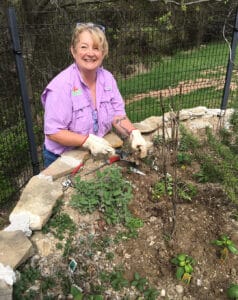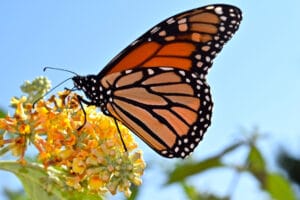Outside the education department offices at Fossil Rim Wildlife Center’s Wolf Ridge Nature Camp, there is a gradually expanding official Monarch Waystation © and pollinator bed.

This extends the length of the buildings and surrounds the keyhole garden, which currently boasts an array of “sensory” plants that appeal to one’s senses of touch, taste, smell, sight and sound. The Monarch Waystation is planted with host plants for monarch larvae on their journey north each spring, and also nectar plants for the adult monarchs – both on the journey north and the return journey south each fall. The pollinator gardens are filled with native plants to supply nectar for a wider variety of pollinating butterflies, moths, hummingbirds, wasps, flies, bees and beetles.
“Native” is kind of a vague term. Do I mean native to Texas, native to the United States or to our solar system? Here at Fossil Rim, the term “native” is very specific: all of the plants we put in are native to this three-county area of Somervell, Johnson and Hood counties.
In building the gardens, we utilize either broken-down cardboard boxes or brown paper feed sacks. This falls in line with our vision of recycling and upcycling, plus it adds needed carbon to the soil as the paper and cardboard breaks down over time. After weeding and/or rototilling to remove as much grass as possible, we lay down feed sacks or cardboard and then cover with four inches of mulch, which we get free from our local transfer station.

We have found this keeps our garden weed-free and grass-free for two years, and then we need to weed again and reapply. To add plants after the cardboard and feed sacks have already been put in place, we simply cut a hole through the cardboard big enough to dig a hole for the new plant and mulch up to the edges of the hole afterward, while being sure not to get mulch too close to the plant stems. This helps us to avoid insect damage or disease.
All of the gardens are great educational tools to reinforce our message of conservation. They also encourage conservation projects that can be done at home, promote protection of our native species and our exotics, while also fostering the reuse of items – in this case paper, cardboard and wood – that would normally be sent to a landfill.
-Tessa Chenoa Ownbey, Director of Education
